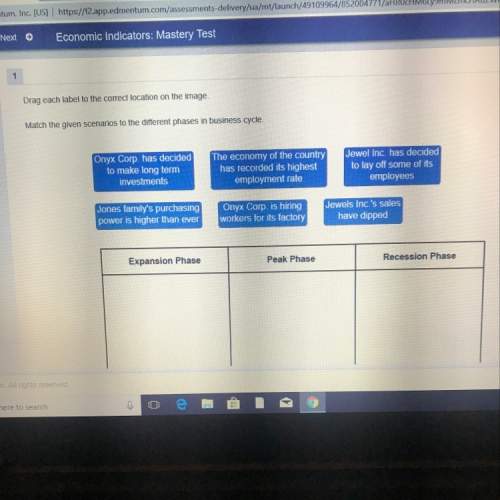
Business, 27.11.2019 23:31, montgomerykarloxc24x
Which of the following explanations is consistent with the decline in productivity growth that followed the great recession? multiple choice high levels of debt incurred prior to the great recession have hindered firms’ ability to make productivity-enhancing investments. the federal reserve kept interest rates too high, stifling investments that would increase productivity. high levels of inflation following the great recession created too much uncertainty for firms, discouraging productivity-enhancing investments. consumer demand following the great recession exceeded firms’ capacity to satisfy that demand.

Answers: 2
Other questions on the subject: Business

Business, 22.06.2019 12:10, weeman6546
Lambert manufacturing has $100,000 to invest in either project a or project b. the following data are available on these projects (ignore income taxes.): project a project b cost of equipment needed now $100,000 $60,000 working capital investment needed now - $40,000 annual cash operating inflows $40,000 $35,000 salvage value of equipment in 6 years $10,000 - both projects will have a useful life of 6 years and the total cost approach to net present value analysis. at the end of 6 years, the working capital investment will be released for use elsewhere. lambert's required rate of return is 14%. the net present value of project b is:
Answers: 2

Business, 22.06.2019 12:50, tayjohn9774
Kendrick is leaving his current position at a company, and charlize is taking over. kendrick set up his powerpoint for easy access for himself. charlize needs to work in the program that is easy for her to use. charlize should reset advanced options
Answers: 3

Business, 22.06.2019 14:00, breana758
Bayside coatings company purchased waterproofing equipment on january 2, 20y4, for $190,000. the equipment was expected to have a useful life of four years and a residual value of $9,000. instructions: determine the amount of depreciation expense for the years ended december 31, 20y4, 20y5, 20y6, and 20y7, by (a) the straight-line method and (b) the double-declining-balance method. also determine the total depreciation expense for the four years by each method. depreciation expense year straight-line method double-declining-balance method 20y4 $ $ 20y5 20y6 20y7 total $
Answers: 3

Business, 22.06.2019 17:50, ratpizza
Abc factory produces 24,000 units. the cost sheet gives the following information: direct materials rs. 1,20,000direct labour rs. 84,000variable overheads rs. 48,000semi variable overheads rs. 28,000fixed overheads rs. 80,000total cost rs. 3,60,000presently the product is sold at rs. 20 per unit. the management proposes to increase the production by 3,000 units for sales in the foreign market . it is estimated that semi variable overheads will increase by rs. 1,000. but the product will be sold at rs. 14 per unit in the foreign market. however, no additional capital expenditure will be incurredq-1. what is present profit of the company ? q-2. what is proposed profit of the company in new market? q-3.what is suggestion for new makret proposal whether proposal accept or not
Answers: 1
Do you know the correct answer?
Which of the following explanations is consistent with the decline in productivity growth that follo...
Questions in other subjects:




Computers and Technology, 27.01.2021 02:10

History, 27.01.2021 02:10




Mathematics, 27.01.2021 02:10

History, 27.01.2021 02:10







